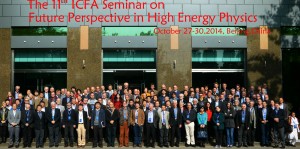The ICFA seminar is a meeting held every three years, rotating through the Americas, Asia and Europe. The last meeting in 2011 was held at CERN, and the most recent one in Asia at the Institute for High Energy Physics (IHEP) in Beijing from 27 to 30 October. The next meeting in 2017 will be in Vancouver, Canada.
The meeting is organised by the International Committee on Future Accelerators (ICFA) and attended by representatives from countries, with a total attendance of about 200. The format consists of invited plenary talks which provide high-level overviews of the current state of particle, nuclear and astrophysics and plans for future facilities around the globe. The program for the Beijing meeting can be found here. More information about all ICFA activities is here.
Instead of trying to give a summary of the whole ICFA seminar here I will concentrate on high-energy colliders, with a bias towards ILC, and presentations and discussions around this topic.
In the last decade future high-energy colliders considered were lepton colliders with centre-of-mass energies between 500 GeV and ~3TeV and they were the ILC, CLIC and the muon collider. They were developed to different degrees of realism, varying from a Technical Design Report for the ILC, a Conceptual Design Report (CDR) for CLIC and a concept for the muon collider. Recent strategic planning exercises and the discovery of the Higgs boson have fueled new ideas for future colliders. The measurement of Higgs boson properties is “a tool for discovery”, to quote the US P5 report. There is now a series of studies and design reports for several possible future colliders with varying degrees of readiness. In the next ten years the LHC and its upgraded version will be the tool to explore the Higgs and possible signs of new physics. Beyond that the picture of future facilities emerging from the ICFA seminar has become more diffuse. The P5 report in the US recommended not to pursue the muon collider concept any longer. The ILC is ready to be built and the world is waiting for a sign from Japan on whether it will offer to host. China is proposing to build a circular electron-positron Higgs factory, with centre-of-mass energies between 250-350 GeV, followed by a ~80-100TeV proton-proton collider in the same tunnel. The plan is to have a CDR for the Higgs factory around the beginning of 2015 and a preliminary time line would have the machine operational by the end of the next decade. In parallel with the on-going CLIC study, CERN has initiated a 100-TeV proton-proton collider study in a new tunnel, which might also be used to house a electron-positron Higgs factory. Although inside our field we understand the different stages of readiness and physics reach of these future facilities, it is my concern that outside of our field the difference between studies and technical design reports are not so well understood. Concerning electron-positron colliders it should also be noted that once a straight-line tunnel is constructed for, let’s say, a 500-GeV machine, the linac in such a tunnel could be upgraded in the future as new acceleration structures with much higher gradients become available
There was also a discussion at a round table about global collaboration and a globally coordinated programme. The strategic plans in all regions that were developed in the last two years all align with a strategic global approach to particle physics in terms of building facilities. It is obvious that the LHC and its upgrades have global support and participation and it is a programme that all regions want to see realised, because it is the only energy frontier collider that will run for the next ten years. Looking beyond the LHC there are regional initiatives (neutrino programme in US, possible ILC in Japan) that are being pursued. However, there is no clear mechanism on how to achieve consensus on what constitutes THE global programme, with facilities in regions that are complementary and together form a unique and coherent approach to address the relevant questions in physics. No clear answer on how to achieve this emerged. Our community feels that it would be great if such a global programme could be put together, so that new expensive facilities can be build that cannot be realised by individual countries. Maybe the human race is simply not ready for that yet and more globalisation has to happen before this can achieved…



Recent Comments